
Renault's Technical Chiefs
Atlas F1 Technical Writer
Renault had a 2004 season full of ups and downs, with a difficult car which failed to fight at the very top. Atlas F1's Craig Scarborough spoke to technical directors Bob Bell and Rob White at the close of the season about the cars details and its performance throughout the year
However, the hub of the staff remained, some since the Schumacher days and even Toleman before that. Key figures such as Pat Symonds and other engineering staff retained the teams' strengths and coped with the change from being a constructor with an engine supplier, to that of one team making the whole car, albeit under two roofs in two countries.
2004 saw the core of the team continue with two new technical heads: Bob Bell was promoted to technical director (chassis) and Rob White was recruited from Cosworth to head the engine dept at Viry Chatillon in France. This new pairing were able to capitalise on the team's stable under-pinnings.
For the 2004 season, the team rolled out a package that was a major departure from the chassis and engine seen in 2003. While Bell was already overseeing work on the 2004 car, as part of the alternating design teams instigated by Gascoyne, the new direction taken with the engine for the one engine per weekend rules, had to suffer a shortened development time.
2004 was unusual in that the rules remained largely similar for the chassis and but with a major change on the engine. The season that subsequently unfolded saw Williams and McLaren fall out of their usual top three position, while BAR rose to challenge Ferrari. Renault sat between these teams, challenging BAR for second in the Championship. However their season was not an easy one as the car struggled with sensitive handling and less power than their rivals. But with a single win and five podiums Renault did produce results from their new package.
Q. How has your job changed in becoming technical director?
Bell: I was previously deputy technical director at Renault, I worked to coordinate the fact we had these dual processes running through the company and how that all interrelated with aero facilities, test facilities and Viry, plus I acted for Mike [Gascoyne] when he wasn't around.
Q. So it's a similar role?
Bell: Virtually identical. Only a few extra jobs, but it's very similar that's why its a been a smooth transition for us
Q. During the design phase what were the targets for the new car?
Bell: Over the performance gains in terms of aero performance would have been in the order of 10-12%.
Q. The car has been a lot more sensitive to set up this year, were these aero or mechanical problems
Q. In the tunnel designing and choosing pieces how do you establish if parts are going to be sensitive?
Bell: We have, as do all teams, very clear criteria by which we accept development components on the car, the criteria obviously have to involve the aerodynamic efficiency levels that we are to accept. Downforce as the basic obvious one and then we have criteria for performance in yaw and several other criteria, pitch obviously and several other secondary criteria as well. We balance all of the those and will form a judgement to accept something or not, I think that the process is evolving all the time and I think we get better and better at judging which components will give you issues regarding handling characteristics. The simple efficiency of the car is relatively straight forward and predictable from tunnel to track, but some of the more subtle handling characteristics less so, and I think we learned some lessons this year in that respect which stand us in good stead.
Q. The sheer rate of aerodynamic development and the complexity of the aerodynamic pieces are impressive?
Bell: Aerodynamics these days is unfortunately all about productivity in the wind tunnel, it's all about trying to put as many development pieces through the tunnel as you possibly can and thereby improve your success rate of putting development pieces on the car. That's fairly crude way of looking at it and it is by and large true, but we try and do other things to make that process more efficient, on other word we try and put more items through the tunnel that are likely to be successful and increasingly CFD and theoretical methods certainly helps that we were improving the technology all the time so that's made a big difference to us it has allowed us to put more components on the car during the course of the season and of course the other thing is the regulations remain relatively stable and we're making smaller and smaller gains the changes we are making to the car are ever more subtle and ever more complex in terms of the geometry things are becoming more three dimension.
Q. Is the Tunnel running 24-7 aside from maintenance?
Bell: It's not quite that but it's getting close to that and that will be pushed up to those sorts of level over the next year or so.
Q. What's the rotation time in the tunnel the total process, from getting the part on the model, running through the tunnel to the end results?
Bell: It's fairly quick process actually, you know the typical wind tunnel run of any component lasts 30 minutes and typically the average time to change a component on the wind tunnel model is 30 minutes of course. We will often do more than one run for a component, very often that's the norm so there'll be several 30 minutes runs. If it's a very clear cut improvement then the geometry that we've checked can be released into the full scale car development process almost immediately. The long lead items for the wind tunnel are the manufacturing of the tunnel components, so less than the actual tunnel test time. The tunnel can usually eat more components than we can actually make
Q. You adopt a lot of the 3D stereo lithography systems to make wind tunnel parts
Bell: Yes, at the minute in fairness we have our manufacturing base reasonably well balanced to the wind tunnel capacity, in think it's generally the case you can test more than you can make at the minute if we were to increase our tunnel testing time our bottle neck would definitely be in the ability to design and manufacture the components for testing than rather than the actual process of testing.
Q. The sidepod shape is much more extreme this year?
Bell: We took some fairly ballsy moves in packaging the car, we really squeezed it and we've done some novel things with the packaging of the car to achieve that. I don't think it was a huge risk actually to be honest; it's involved a lot of work and a lot of attention to detail. There's a lot of work to make the whole package live and do what's expected of it, we've got a great bunch of people who are very experienced. They're up for a challenge and they rose to it.
Q. You needed to put in a lot of grills to cool the car
Q. You have a unique rear wing arrangement with the flap moulded into the endplate; do you have a catch word for that?
Bell: Not really, Integrated flap and endplate system.
Q. It bleeds high pressure form between the endplates to the wing tip intersection?
Bell: Yes, it's a very critical area of the rear wing design because of that upper edge of the endplate is where the tip vortex comes off is generate and streams off backward. Anything you can do there as regards of local management can have quite a substantial effect on the performance of the wing. It's quite a sensitive area, so we pay a lot of attention to that and that's why you now see the complexity in that area.
Q. At Imola you introduced the vertical slot in the rear wing endplate?
Bell: I mean, again, it's a bit of local flow management. It's a very three dimensional flow in that part of the wing and I suppose one way of looking at it is to say the net effect of it actually the wing to think it's slightly bigger than it actually is.
Q. You also adopted two mid wings, narrower and different in layout to other people, what were you trying to achieve?
Bell: I think that we were probably not trying to do anything particularly different. It is interesting that the span of other people's solutions ended up bigger than ours which would be the logical, we just didn't find that benefit. We found a reduced span for whatever reason. It's hard to know what that reason is as we don't have access other peoples data. It just seemed to work for us.
Q. Were they producing their own downforce or trying to bend the flow?
Bell: Two things I suppose you obviously try to make any component carry some downforce in itself and carry it efficiently and also it's a bit of flow management for the air that's going backwards and encountering the rear wing
Bell: I wouldn't necessarily say it was strictly the tip vortices that were the root of their influence, but it does have a small impact of the onset flow conditions for the rear wing and by tailoring those upstream wing elements you can produce a more sympathetic flow for the rear wing
Q. Intuitively the flow over the car ahead of the rear wing is horizontal, is that correct?
Bell: If you took the rear wing away it would be roughly horizontal but the rear wing itself has a huge impact on the direction of the flow that approaching it so it does make the flow direction not at all intuitive.
Q. At Monaco you introduced the winglet on the bargeboard, was that to flick up the flow to avoid it going under the floor?
Bell: Yes, again, it's like lot of these little add-ons: it's really flow management for what's behind. I think it's got a lot to do with the way the flow is directed and encounters the body. Of course the big bargeboards everybody runs do throw off some fairly complicated flow structures, mostly carrying a large vortex which gets sucked under the car and those little appendages just manage the direction and strength of that flow that's thrown off the bargeboards.
Q. Has the layout of the car changed i.e. fuel cell?
Bell: It's smaller, not dramatically.
Q. And wheelbase?
Bell: It's slightly different, not really as a consequence of saying we need a different wheelbase just a consequence of the packaging .
Q. It is suggested the team went out to produce a rearwards weight bias for traction benefits, was this the case?
Bell: We have a clear view on where we want to put the weight distribution, we're probably not quite as fortunate as some teams in being able to put it where we like this year. Because for one reason we have a slightly heavier engine because it's an older architecture of engine and that tends to bias us towards the rear. But we have found just through general testing and development that that weight distribution suits us and yes it does give you traction advantage off the line and during circuit running, but it's not the whole story by any stretch of the imagination and we certainly don't go around making components deliberately heavier just to make a traction advantages.
But rearwards weight distribution is only a small part of the reason we've got good traction and we get away well from the line. It's not as simple at that, we've got some very good people here, very good controls systems and a very good view on how to set the car up to maximise good traction. That's a lot more subtle than simple building a rearward weighted car
Q. Why was a full cast titanium gear case chosen over the hybrid or full carbon?
Bell: We did a fairly in depth study as to what we should do; full carbon, full titanium or hybrid. Between the hybrid and full titanium was neck and neck. The trouble particularly with a complex carbon structure like that, is it's actually difficult to assess its final weight until you've built one and got it through all of its tests. It was that closely balanced, that until we had actually built one and run it we would never really know what is was finally going to weigh in at. So we plumped for titanium because we thought it would just be in favour of the hybrid and once we actually built one and operated it, it became clear that the balance in reality was probably very slightly the other way. But we've also put a lot of effort into developing the techniques to make all titanium boxes and so were actually better placed this year than we were last year, so the balance is now in the favour of TI.
Q. Didn't having the ability to carbon pieces in-house provide some benefits?
Bell: It's interesting because, in fact, the carbon component demands a lot of manufacturing capacity in-house to build. They are very complex carbon pieces, they eat up a lot of composite manufacturing capacity, with the Ti box virtually all of the manufacturing is done outside. So it frees up capacity within the organisation to focus on the bits that need development during the course of the season, as once you've done the gearbox you tend to leave that on all season, it was a question of optimising resources.
Q. After Jarno's Silverstone crash you made a titanium upper wishbone?
Bell: It was expediency really. It certainly was as light as carbon, but as a result of Jarno's accident it was fair to say we never completely satisfied ourselves what the cause of it was and we were unable to recover all of the debris so we had pieces missing and we couldn't categorically say what the cause of the failure was.
So more out of respect to safety we adopted a metal solution we had a lot more confidence in the design of.
Q. So it wasn't a general move to metal over carbon
Bell: No, we had to do something quickly and that was the quickest way to do it and in actual fact it worked out quite well. It was decided ultimately the best thing to so was maintain that for what remained of the season
Q. You've been making the upper rear wishbones in one piece, was that to provide an increment in stiffness?
Bell: Yes, it was a nice piece and it was a complex piece to make in both carbon and metal. Things like that do carry their own problems, bigger pieces like that get more risk of damage in fitting, transit and all these things. So it's something you have to be careful with, we constantly review that whether that it is appropriate solution.
Q. At Monaco you reintroduced the strut over the engine, was that to cure inadequacies in the car?
Bell: No, that was something we always wanted to do, we had it on the previous car so it's not new. It was much more difficult to do on this car because of the engine architecture, so we shied away from doing it; because to do it elegantly was going to be heavy and we weren't convinced it was actually going to contribute very much.
However once we started running the car, we did a test and found it could actually contribute to some performance and we put them on in a less than elegant manner but it actually helped a little bit on the car handling issues.
Q. There was also a new lightweight chassis late in the year?
Bell: That was just a programme an on-going programme to take weight out of the car it was quite a useful step forward in that regard, but nothing particularly clever in it.
Q. What sort of weight saving?
Bell: Several Kilos
Q. Which could go straight back on as ballast?
Bell: Yes
Q. You do not run the drooped upper wishbone as some other Michelin runners do, is this not something that is specified by Michelin?
Bell: We've a very close relationship with Michelin; obviously they tell us what the optimum camber, castor and toe-in toe-out parameters for the tyres. How we achieve that dynamically as the suspension articulates is up to us and we I think it's fair to say that last year (2003) we had a car that's very kind to its tyres, we were very mindful of not to changing anything to effect that capability. In terms of the geometry it's very similar to what we've run before, the detailed engineering implementation of it is different, as we're always trying to make lighter and simpler.
Q. How did you handle tyre management, the car seemed to suit all circuits but often we saw a drop off in race?
Bell: Well, we did have a lot of cases during the year where we got a lot of understeer towards the end of the stint and seemed to get excessive graining at some circuits. I suppose some of that is due to the fact weren't running what we might consider an ideal weight distribution for those tyres. Also, there may be a little bit the driving style; Fernando got a very aggressive driving style, which is also very quick. It may have an impact on some of the tyre longevity. Particularly when it's taken into context that perhaps we weren't running the ideal weight distributions for those tyres. It was an issue for us and we're very conscious of it and it certainly did hamper our performance for quite a few races. But it's really not something we could do a lot about, it's something that something that's much easier to address for next year.
Q. Was that part of Jarno's troubles later in the year?
Q. You ran different Michelins to most other teams, were these developed for the team?
Bell: No, we used a tyre that wasn't a common choice. Everybody has access to the same range of tyres; we tended to use a construction that other teams chose not to use. They were perfectly at liberty to do so, as indeed Jaguar did. We were on a construction a lot of other people didn't use, it just seemed to suit our car and we didn't run that exclusively, we used it on a circuit by circuit basis.
Q. How have the new one engine per weekend rules challenged the team?
White: One of the challenges for engines that last longer is the fact that the race is inevitably at the end of the life of the engine. There is a challenge that you present the engine in the best possible state at the race. In the old days it would be a new engine and now it's an engine that's done maybe 3-400Km already, at that stage that in the in the past it would be taken out of the car and sent for a rebuild. Again you have to manage the whole life of the engine with the single most important objective of getting to the end of the race.
Q. Was the RS24 engine ahead of the RS23 for power and reliability?
White: We effectively doubled the life of the engine for the start of this season, therefore it was ambitious target to going to race in Melbourne with more performance than we finished the season before, I guess we were all pleased not to say relieved to do that.
Q. Was the Melbourne spec engine achieving its design targets?
White: Yes, it was.
Q. You were public in releasing peak RPMs, what was preventing running higher RPMs?
White: The first thing to address is whether one is public or not, there really isn't a choice, we can all hear what revs each are doing, it's no great secret, it never has been and never will be. Clearly the absolutely fundamental thing that drives the power of all reciprocating piston engines is how fast the piston goes up and down, the thing we're all trying to do is convince the engine to swallow more air in order that we can mix fuel with it, burn and generate mechanical power. The first thing that increases the amount of air that travels through the engine is the engine speed. So clearly in terms of improving the performance of this kind of engine, in which there is no physical restrictions, there is no regulation imposed like a restrictor, it's the amount of air we can swallow that is very important to all of us.
Q. Were Longevity or combustion problems preventing higher RPMs?
Q. With a limit on the peak RPM you were able to achieve, was drivability improved getting more power under the power curve?
White: Again it's the classic work of engine development, we all get seduced by the big number at the top of the curve and that's clearly relevant. But in terms of making the car quicker it's not the whole story, it's something we absolutely did work on during the life of the RS24. We worked to lift the big number at the top of the curve, but also to increase the useful speed range of the engine to make sure the curve was filled and improved wherever the driver wanted to make use of it. So there really isn't a choice, you need to look in this fashion in order to extract the best performance from the car.
Q. Renault's greatest gain was in traction, this was partly down to the chassis but also partly the engine, is there a preferred shape to the power curve to gain more traction?
White: Fundamentally our mission is to provide as much torque as we can whenever the driver has his foot to the floor. Whenever the driver wants more torque our ambition is to deliver it. In concrete terms that means a broad torque curve, it means one with out any nasty inflections, it's certainly one of the great challenges of modern F1 that it will run cleanly and pull correctly over a very broad speed range; from 5k RPM around the hairpin at Monaco to 18.5k RPM in a very short time afterwards when you change gear. So useful speed range is important and can be quite important and can be quite difficult to achieve.
Q. Coping with the broad speed range, the fuelling for the engine is critical, how do you get the fuel injectors to cope with the low end rev range up to 19k RPM?
White: Clearly the strategies for engine control are very important, with the design of the pieces for all of the sensors, actuator and the control systems. So the delivery of the fuel and air is very important, modern high speed engines are very sensitive to mixture preparation it is something that we work on non stop. You clearly don't have very long in which to deliver the fuel for each firing stroke. Therefore you have to choose an injector which has the necessary flow rate, so when it's open it can deliver the correct amount of fuel. Then it's detail of the injector and the fuelling circuit that supplies the injector to make sure the stuff comes out the nozzle in a appropriate position to go down the port and hopefully it burns.
White: Again one of the fundamental goals of engine development is to do the best possible job with fuel efficiency. We treat it very seriously, we work explicitly on fuel efficiency. The good news is the things one works on for performance development typically pay in fuel consumption. It's interesting to note that the specific fuel consumption of modern F1 engines is very good indeed at ridiculous high engine speeds. It's not very far away from the little diesel engines you go down to the shops in. We clearly manage it very carefully.
Q. The team only had two engine failures in races from oil problems, were these related?
White: They were related to one another: we had a failure in Jarno's car in Hungary and we made some changes in that area of the engine with which both cars raced in Belgium. The part first failed during the testing ban and despite having very little time between races we managed to design and make some alternative pieces which completed two race distances on the dyno. Then a related thing happened to the car of Fernando at Spa, we were all deeply frustrated to have a related incident. It happened at Spa particularly with the funny direction gravity operates at the crest of Eau Rouge.
The thing that is peculiar is the crest of the hill at Eau Rouge it's like going over a hump back bridge. The oil travels upwards in the oil tank and the difficulty is keeping the oil supplied to the engine. In the time that the oil is going upwards it's unlikely to be going into the engine, which is not optimal. We were able to refine the pieces for Monza, which was the following race and we had no more troubles in that area. It was an absolutely a stark reminder that in the expensive world of F1 the little things can catch us out and these were very small inexpensive pieces that failed, but were disappointed not to be able not to have responded.
From where they stand today, the Renault team have gone through many reincarnations. The race team actually stem from the old Benetton team and the Toleman team before that. While the engine team harks from the Works-based team competing as a manufacturer in the eighties and as an engine supplier in the nineties.
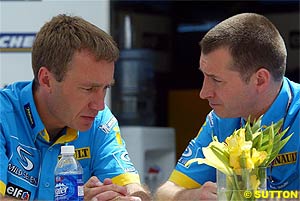 It's now nearly ten years since their last World Championship and four years since Renault took over. The team have been building over the past four years, with a technical team lead by Mike Gascoyne on the chassis side and Jean Jacques His in charge of the engines. By 2003 the team were on the pace and winning races, with that stability reaping rewards, but then endured more staff changes with both the technical heads leaving.
It's now nearly ten years since their last World Championship and four years since Renault took over. The team have been building over the past four years, with a technical team lead by Mike Gascoyne on the chassis side and Jean Jacques His in charge of the engines. By 2003 the team were on the pace and winning races, with that stability reaping rewards, but then endured more staff changes with both the technical heads leaving.
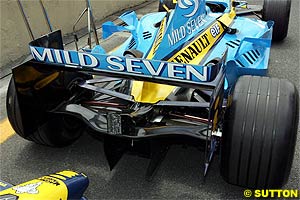 In January 2004 the two new technical chiefs revealed their new car under the ornate roof of the opera Hall in Palermo, Sicily. While previously the team heads were the more gregarious Flavio Briatore, Gascoyne and His, the two new technical staff were much more modest and low-key. Both being quietly spoken and more used to the drawing office, than the grandeur of the launches.
In January 2004 the two new technical chiefs revealed their new car under the ornate roof of the opera Hall in Palermo, Sicily. While previously the team heads were the more gregarious Flavio Briatore, Gascoyne and His, the two new technical staff were much more modest and low-key. Both being quietly spoken and more used to the drawing office, than the grandeur of the launches.
 Bell: It's often the case and I think this is the case with our situation, it's a bit of both, and I think that's why it's sometimes hard to identify and rectify the problems. I think there is an element of mechanical aspects of the car and an element of the aerodynamic aspects of the car, both of which we worked quite hard at over the season to improve and we did make quite sizeable steps forward. The difficulty in judging that is the fact is even if you did nothing the drivers get used to it and compensate for it, so it's hard to quantify from the subjective comment for the driver because of that. So the difficulties we had from the car were not really identifiable from the stop watch, the drivers could drive it quickly, it was a quick car. It's just it was more difficult do so and that's not always obvious from logged data on the car or from the stop watch. I think if we put them in an R23 now they would see a big improvement over the car we gave them at the start of the season.
Bell: It's often the case and I think this is the case with our situation, it's a bit of both, and I think that's why it's sometimes hard to identify and rectify the problems. I think there is an element of mechanical aspects of the car and an element of the aerodynamic aspects of the car, both of which we worked quite hard at over the season to improve and we did make quite sizeable steps forward. The difficulty in judging that is the fact is even if you did nothing the drivers get used to it and compensate for it, so it's hard to quantify from the subjective comment for the driver because of that. So the difficulties we had from the car were not really identifiable from the stop watch, the drivers could drive it quickly, it was a quick car. It's just it was more difficult do so and that's not always obvious from logged data on the car or from the stop watch. I think if we put them in an R23 now they would see a big improvement over the car we gave them at the start of the season.
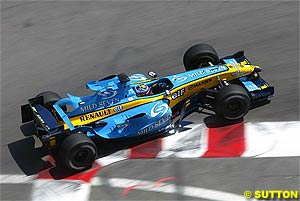 I suppose is one way of looking at it much more sophisticated in terms of the geometry involved and so those two strands of what you will see develop on our car I think we felt in actual fact we felt that towards the end of the season we could have a better job in putting keeping the pace of the development going for longer, but it was actually difficult this year because of the fact that the regulations for 2005 dictated such a different aerodynamic configuration of car we put all of our effort in the latter part of the season into the development of next year's car, where as the previous year the two configurations were a lot closer and the transfer of components that were developed on one to another that kept the development of the 23 car going later into the season.
I suppose is one way of looking at it much more sophisticated in terms of the geometry involved and so those two strands of what you will see develop on our car I think we felt in actual fact we felt that towards the end of the season we could have a better job in putting keeping the pace of the development going for longer, but it was actually difficult this year because of the fact that the regulations for 2005 dictated such a different aerodynamic configuration of car we put all of our effort in the latter part of the season into the development of next year's car, where as the previous year the two configurations were a lot closer and the transfer of components that were developed on one to another that kept the development of the 23 car going later into the season.
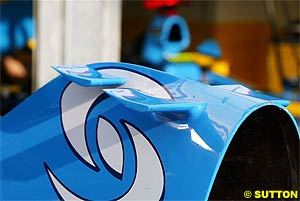 Bell: We fundamentally have to get the warm air that's passed through the radiator out the back somewhere. The whole thrust in F1 nowadays is to narrow down the back. The rules of physics dictate that you have to have a certain size, so rather than one big hole we have specifically selected areas of the bodywork at the rear where we can successively open in progression, depending on the cooling level we want. To provide the cooling level that's necessary and do it in a way that minimising the impact of the external aerodynamics.
Bell: We fundamentally have to get the warm air that's passed through the radiator out the back somewhere. The whole thrust in F1 nowadays is to narrow down the back. The rules of physics dictate that you have to have a certain size, so rather than one big hole we have specifically selected areas of the bodywork at the rear where we can successively open in progression, depending on the cooling level we want. To provide the cooling level that's necessary and do it in a way that minimising the impact of the external aerodynamics.
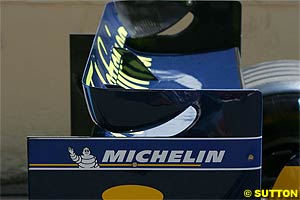 Q. So is it the tip vortices doing the work of the winglets profile?
Q. So is it the tip vortices doing the work of the winglets profile?
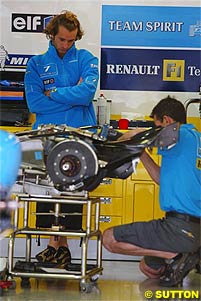 It's what every one does, to the make the car as light as they possibly can and the put ballast where they feel it's necessary to alter the weight distribution and so on and were no different in that regard to any other team. I don't think we are doing anything different or clever; we just follow the same approach as most other teams do, and we have slightly restrictions this year because of the engine. I think we could have taken more weight out of the car.
It's what every one does, to the make the car as light as they possibly can and the put ballast where they feel it's necessary to alter the weight distribution and so on and were no different in that regard to any other team. I don't think we are doing anything different or clever; we just follow the same approach as most other teams do, and we have slightly restrictions this year because of the engine. I think we could have taken more weight out of the car.
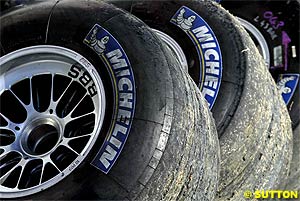 Bell: Yes, I'm fairly sure that didn't help him. Unfortunately with Jarno, he's a driver who perhaps reacts more adversely to problems in the car than other drivers. Fernando and several other drivers take a problem and you see the deficit in performance that the problem gives directly in the car. What those drivers do is not make it any worse, where as Jarno is very sensitive to the smallest issue with the car and it will affect how he feels about the car, he can make a problem actually appear a lot worse in terms of laptime. Fernando, with perhaps a more aggressive style and other drivers with a more aggressive driving style who are more forgiving of deficiencies on the car, will not let that effect the performance or it won't be reflected in the performance quite so much. I think it did have an impact. You can only say that Fernando accepts the car as it was and he extracted the most than anybody could.
Bell: Yes, I'm fairly sure that didn't help him. Unfortunately with Jarno, he's a driver who perhaps reacts more adversely to problems in the car than other drivers. Fernando and several other drivers take a problem and you see the deficit in performance that the problem gives directly in the car. What those drivers do is not make it any worse, where as Jarno is very sensitive to the smallest issue with the car and it will affect how he feels about the car, he can make a problem actually appear a lot worse in terms of laptime. Fernando, with perhaps a more aggressive style and other drivers with a more aggressive driving style who are more forgiving of deficiencies on the car, will not let that effect the performance or it won't be reflected in the performance quite so much. I think it did have an impact. You can only say that Fernando accepts the car as it was and he extracted the most than anybody could.
 White: Again here is a recurring theme, in that you need to do both. You need to have a mechanical specification of the engine that allows you to run the engine at speeds necessary to get the best track performance according aerodynamic-acoustic specification you have in the tuned parts of the engine. Likewise, you have to have an aerodynamic-acoustic specification that matches the existing mechanical capability. It's a mistake to tune the engine to a speed that's higher than the speed you can operate at. It's very much a balancing act and you need to move forwards with that, if not simultaneously than one step after the other.
White: Again here is a recurring theme, in that you need to do both. You need to have a mechanical specification of the engine that allows you to run the engine at speeds necessary to get the best track performance according aerodynamic-acoustic specification you have in the tuned parts of the engine. Likewise, you have to have an aerodynamic-acoustic specification that matches the existing mechanical capability. It's a mistake to tune the engine to a speed that's higher than the speed you can operate at. It's very much a balancing act and you need to move forwards with that, if not simultaneously than one step after the other.
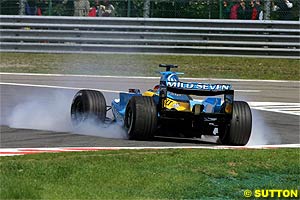 Q. The Renault was noticeably fuel efficient was this an aim for the engine?
Q. The Renault was noticeably fuel efficient was this an aim for the engine?
|
Contact the Author Contact the Editor |
Please Contact Us for permission to republish this or any other material from Atlas F1.
|
Volume 10, Issue 48
Interview with Pierre Dupasquier (III)
Interview with Renault's Tech Chiefs
On the Road
Elsewhere in Racing
The Weekly Grapevine
> Homepage |